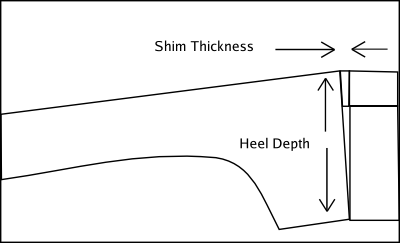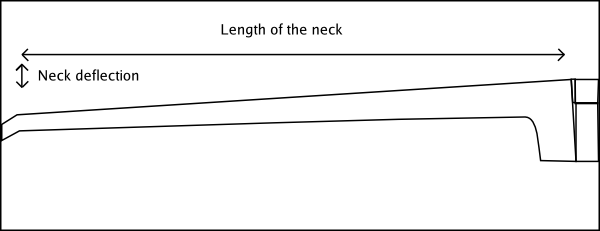
Here it is March of 2005 and I have had my Goldtone Maple Classic for a year and a half. Now that I am more familiar with the banjo, some of its quirks are starting become apparent. It is not that I no longer like it; I like it very much. It is just that I think I can make play it a little better with a tuneup. Here is a list of the issues:
I decided that I would compensate the strings with a Moon bridge. I have one of those on my Bart Reiter, and I really like it. So, I bought a new medium weight, 5/8 inch Moon bridge. I put the Moon bridge on the banjo, and it worked very nicely to compensate the third string. The banjo played nicely in tune. However, it has a slightly curved top and it actually made my action a bit higher, while I was wanting it lower.
Dang!
I measured the height of the strings above the 12th fret and found it to be 3/16 inch. I decided that I would prefer to lower it to 1/8 inch if possible. To do that, I began to consider putting a shim in the neck. But that would be a bit of work, so I looked for a simpler solution.
I found a 1/2 inch straight bridge in my junk box and I put that on. That made the action really nice! It took it right down to 1/8 inch at the 12th fret. It also played mostly in tune with the straight bridge because the strings do not stretch as much when fretted. It played really nicely at that height, so I knew that I wanted to put it there permanently.
I left the 1/2 inch straight bridge on it to try it out. But after playing it like that for a few days I really began to dislike that short bridge. The volume of sound was less, and the tone was not as nice, and my fingerpicks were constantly hitting the head...... and I really wanted to use my Moon bridge.
I decided that I had to do something else, so I went back to the idea of putting a shim in the neck. The questions arose of what kind of shim and how thick it should be. I looked around and found some aluminum flashing out in the garage, and that seemed to be a pretty good material for this. It is pretty thin, so I measured it with my micrometer and found that it is about 0.023 inches thick. Then I wondered if that would be thick enough (or too thick) to do the trick. I calculated the effect of the shim on the neck angle in the following way:
The shim will force the top of the neck out from the pot with the fulcrum at the bottom of the heel. The increase in the angle from the extra space at the top of the neck would be the arctangent of the ratio between the shim thickness and the lever arm of the heel. The following illustration should make this clear.

The tangent of the angle is defined as the length of the opposite side (the shim thickness) divided by the length of the adjacent side (the depth of the heel). So, if we have that ratio, we can calculate the angle by using the inverse of the tangent, the arctangent. So all I need to do is calculate the following:
s = thickness of the shim = 0.023"
h = depth of the heel = 2.75"
a = increase in the neck angle
a = arctan(s/h) = arctan(0.023/2.75) = 0.479º
The question is then, what effect this increase in the neck angle will have on the height of the action.
Since the length of the neck from the heel to the nut is 19 1/2 inches, we can use some similar math to calculate the deflection of the nut from that increase in the angle. Here is a drawing of the neck deflection:

n = length of the neck = 19.5"
a = increase in the angle = 0.479º
d = deflection downward of the nut
d = tan(a) X n = tan(0.479º) X 19.5 = 0.163 inches
That is about 5/32 of an inch. Since the 12th fret is half way between the nut and the bridge, the effect of pulling the nut end of the string down by 5/32 of an inch will pull the string itself about half of that distance closer to the 12th fret, or about 5/64 of an inch. I am looking to drop the string about 1/16, and 5/64 is just over that. So, this is looking like a pretty good guess for a shim.
So, given these preliminary calculations, I came up with the following plan:
The purpose of the lighter strings is to keep them from buzzing against the frets at the lower action and also to make it easier to fret the strings. With this plan in mind, I set out to take the banjo all apart and set it up again with a shim in the neck. I have documented what I did to the banjo beginning on the next page.